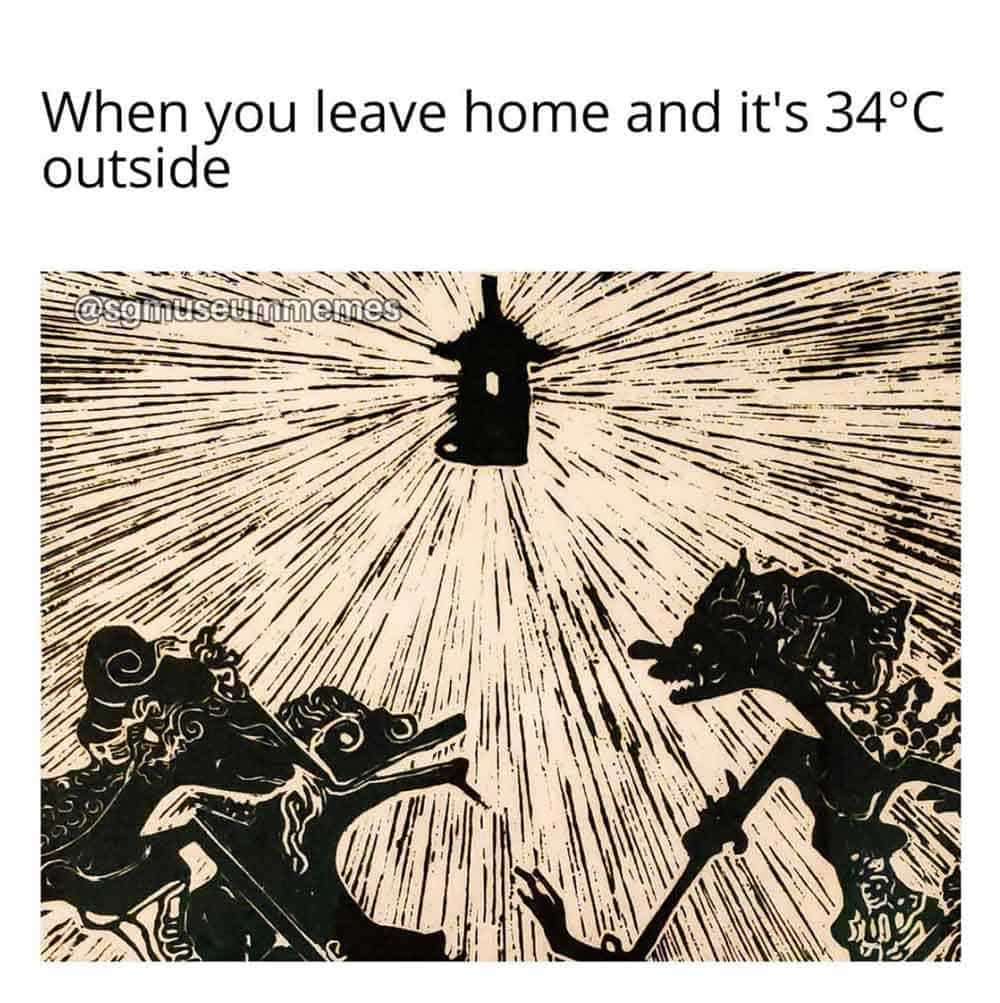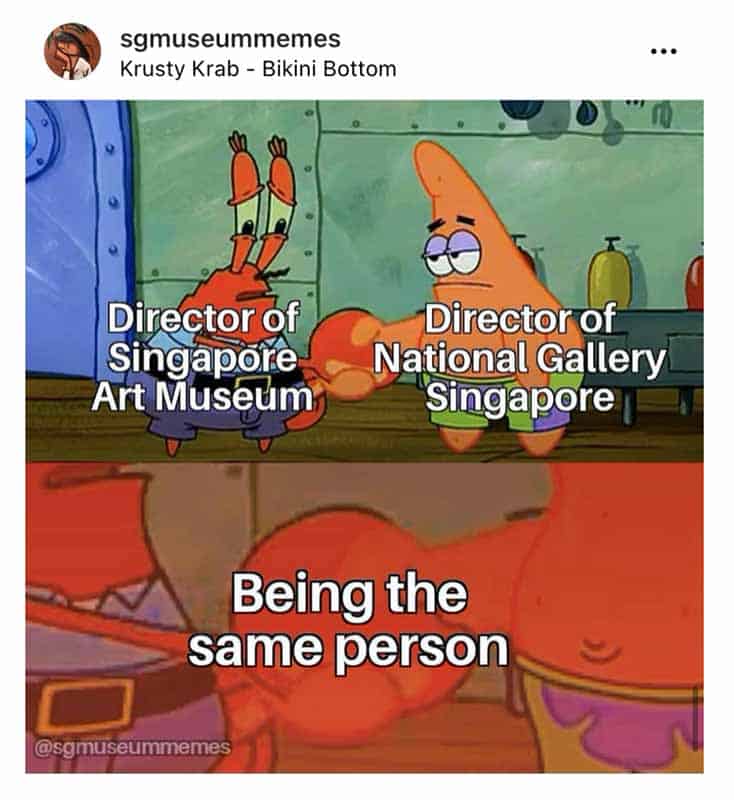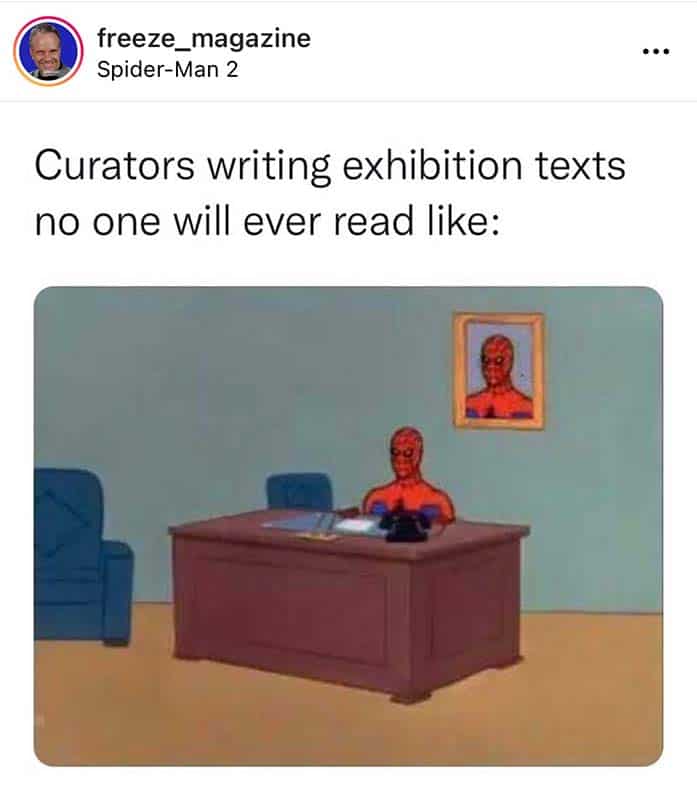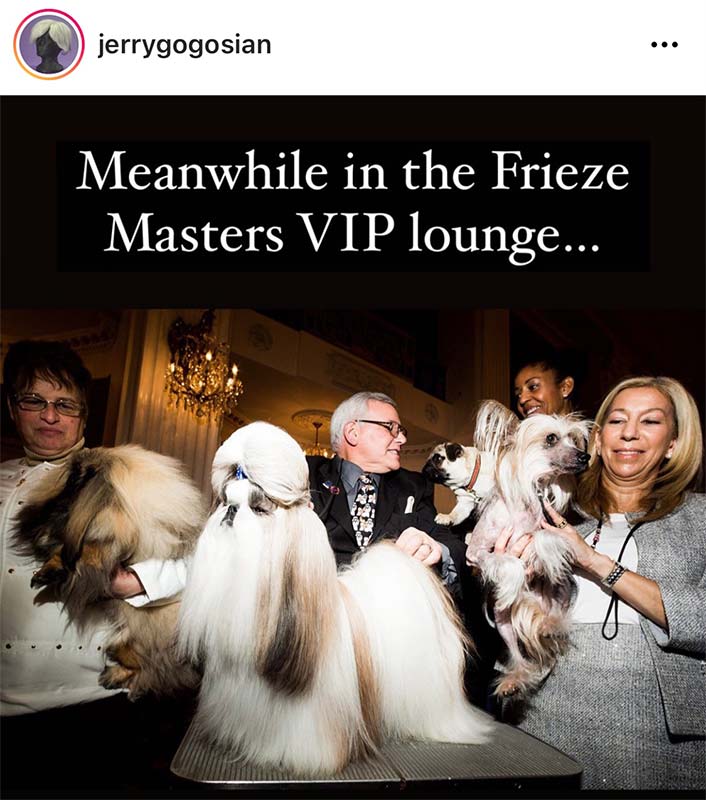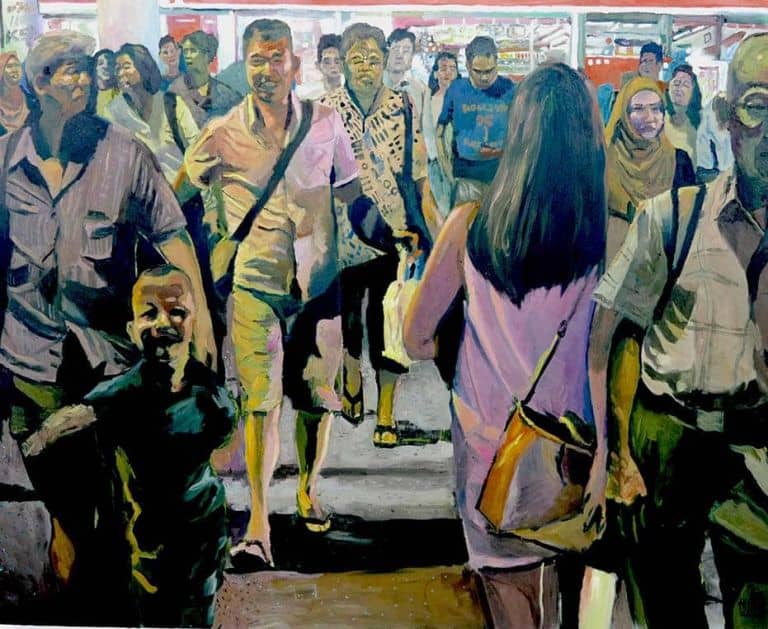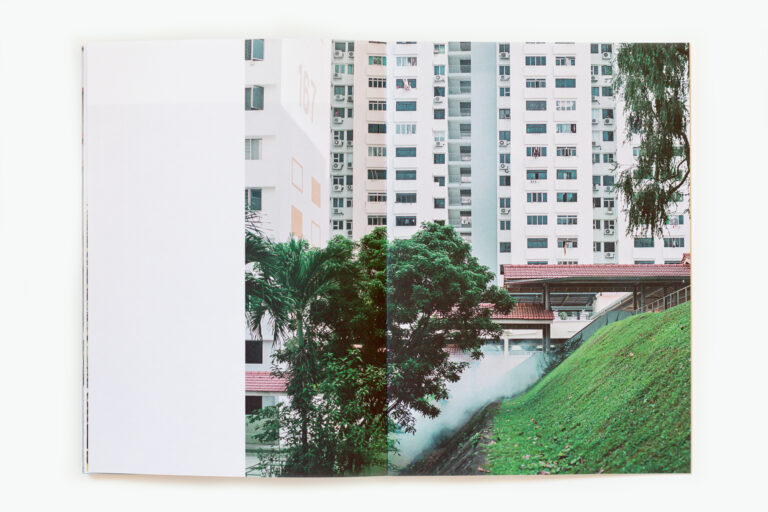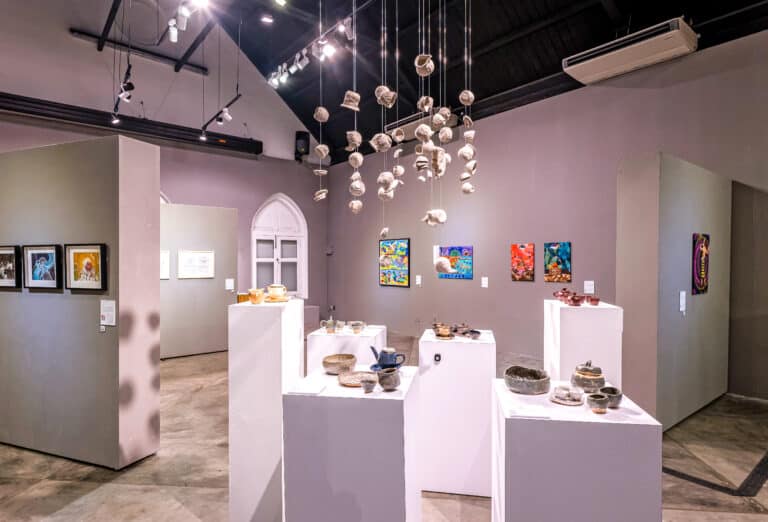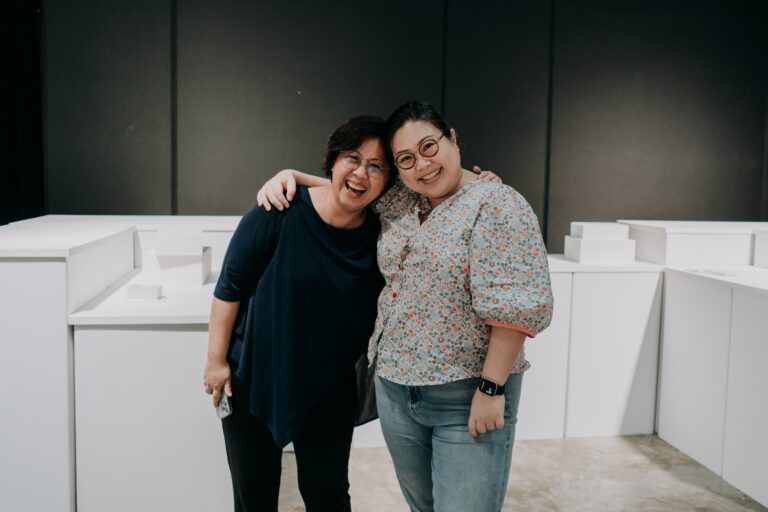While the art world has a bad rap for overcomplicating art and how we should perceive it, a couple of social media accounts have taken matters into their own hands by using memes to poke fun at the industry. Most of these accounts speak to experiences in the American or European art industries but now Singapore has @sgmuseummemes, who roasts our art ecosystem in a way that no one has done before.
Not only have they touched on humorous everyday experiences in Singapore, but they have also drawn attention to serious, pragmatic issues, like how our museums are structured (did you know the National Gallery Singapore and Singapore Art Museum share the same director?) or how ongoing pandemic restrictions continue to affect the public’s mental health — all while referencing artworks and moments in global and Singaporean art histories.
As someone who has worn multiple hats in the industry, I find some level of solace and validation in @sgmuseummeme’s posts, which humorously portrays shared experiences as a culture worker in Singapore’s varied (and, from some perspectives, flawed) ecosystem. Equally enjoyable are the account’s no holds barred reviews of local exhibitions: they aren’t afraid to critique or call out issues from a younger, funnier, and more ‘woke’ lens.
Read on for my interview with the one and only @sgmuseummemes, as we speak about everything from their humble beginnings; how their page has connected audiences across the region and worldwide; and their thoughts on how memes might serve as a new form of art criticism.
What inspired you to start the account? When and how did you get started?
The idea for the page began with Museum Meme Day in 2019. On that day, museums around the world (read: just the UK and the US) roast their collections to heck and back on social media. It went without saying that I was disappointed that Singapore wouldn’t join the fun. That was when I decided to start a page to roast our museums. Be the change you want to see in the world, y’know?
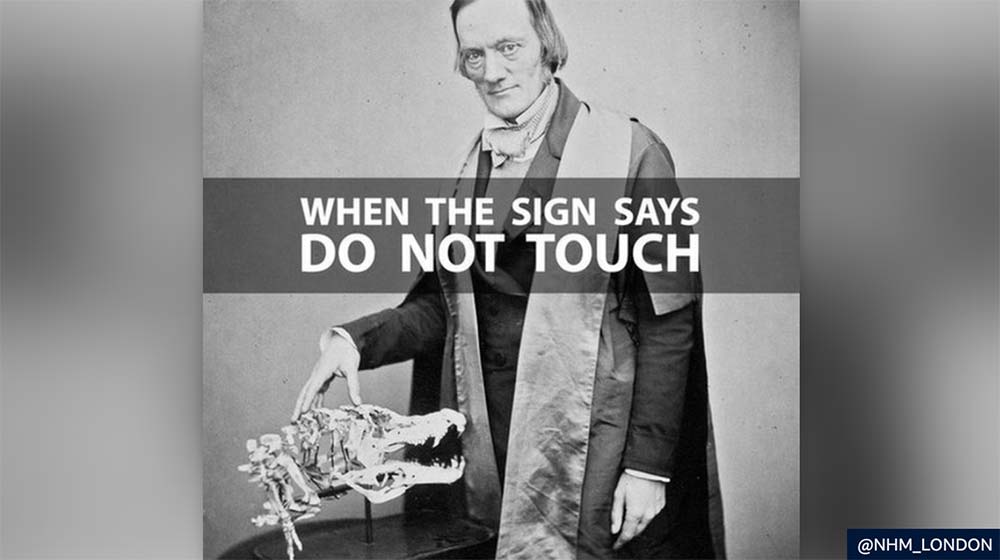
There was also a yawning gap in Singapore’s meme scene for the arts. Yep, that gap between the Singapore news, National Service, and the 90s nostalgia memes. So, there was intent and opportunity, but I held off on starting the page for a long time. It was only on a fine day in October 2020 that I decided to “just whack only.” And here we are.
Why do you think it’s important or valuable to have an account dedicated to Singaporean museum and art scene memes?
While I love classical art memes, I’m not a fan of how these pages on social media almost always feature art from the Western art historical canon. I could rip apart the idea of “classical art” that these memes use, but that’s a conversation for another time.
It’s important to show that the art and heritage closer to home are worthy of our attention. It helps that our National Collection – with its stash of over 275,000 artwork and artefacts — is an existing resource.
I also don’t think we have enough mainstream conversations about our museums. Memes can help the general public gain a better understanding of them. Where the general public is concerned, museum work is still shrouded in mystery. It’s important to be able to consider the museum’s role in society, given the clout they have in shaping mainstream narratives of Singapore’s past, present days, and possible future.
Besides, the lawyers, insurance agents, and social workers already have their own meme pages. Heck, I have friends who are “cherfluencers” (i.e. think teachers who are social media influencers) out and about! A Singapore-based meme page dedicated to artists, culture workers, and art history buffs has been long overdue.
How has the reaction to your page, both from general audiences and culture workers, been?
Largely positive, I think? I didn’t expect to reach a thousand followers, so it was a nice surprise that the page continued growing past that milestone.
I agree that a big part of the good reception has come from artists and culture workers who relate to my memes about the culture industry. Funnily enough, I think this has led to a sizeable following from the same group overseas. I’ve had deep conversations with culture workers from as nearby as Kuala Lumpur and Surabaya, and as far away as Berlin and Chicago. It was also fun to be able to share more about Singapore with folks from outside Southeast Asia.
The past couple of years has seen the rise of meme accounts (such as @jerrygogosian and @freezemagazine) poking fun at the art world and highlighting underlying structural problems of wealth and privilege. Do you have any thoughts on memes and humour as a form of art criticism?
Art and art world memes have both been important in opening up art criticism and the culture industry to wider audiences. The way meme-makers imagine conversations or overlay serious or silly texts on artworks, makes them relatable to many people’s concerns and experiences.
It’s worth distinguishing between art memes and art world memes. Art memes turn artworks into memes, while art world memes highlight the realities of the culture industry. Sometimes, though not very often, a meme does fall into both categories. As art criticism, I think art memes can highlight ideas that art historians and artists — often long entrenched in their own research and practice — may miss.
Besides shining a light on the culture sector’s mysteries, art world memes offer a sense of solidarity to artists and culture workers. Long have they been caught between a complicated industry founded on wealth and privilege and a regular society that has little understanding of their ‘non-essential’ work.
For all my praise, I don’t think memes are without their dangers. In transforming their base artworks, art memes often end up obscuring their original contexts and the potent meanings that can be drawn from them. For now, I’m glad that these memes have brought mainstream attention to the industry. I hope that the same can happen for Singapore.
What is your meme-making process and how do you decide what ongoing news or trends to feature?
One way I do this is by turning an item from the National Collection into a meme, like with classical art memes on social media. It’s either that or I use existing meme templates to poke fun at local museum matters and general museum work. As for what gets featured on the page, I take my cue from other Instagram meme pages, Twitter, TikTok, and a few meme subreddits.
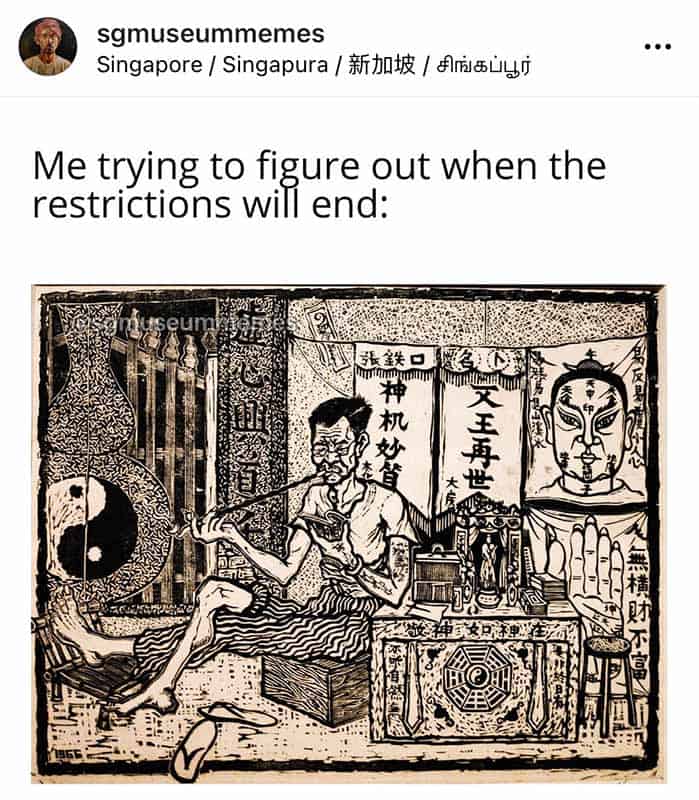
Of course, there are some news topics that are too hot to ignore, and I have to do something about them. Recent examples include the constantly changing pandemic restrictions, the Met Gala, and a certain CEO’s fighting words. Sometimes, I find that there is no good way to fit breaking news into my meme-making process and I end up passing on it.
How do you balance using the humour of meme formats and the more ‘serious’ nature of some artworks?
It depends on how much wriggle room for humour there is in an artwork’s interpretation. I avoid roasting artworks where the depiction of suffering or oppression overshadows any potential for humour. This includes artworks that depict visceral, violent acts or over-the-top drama. Besides these, everything else is fair game.
Your Instagram reviews of exhibitions never fail to make me chuckle and I appreciate how fun your views are! Is there a particular message or perspective about art that you hope to share with these reviews?
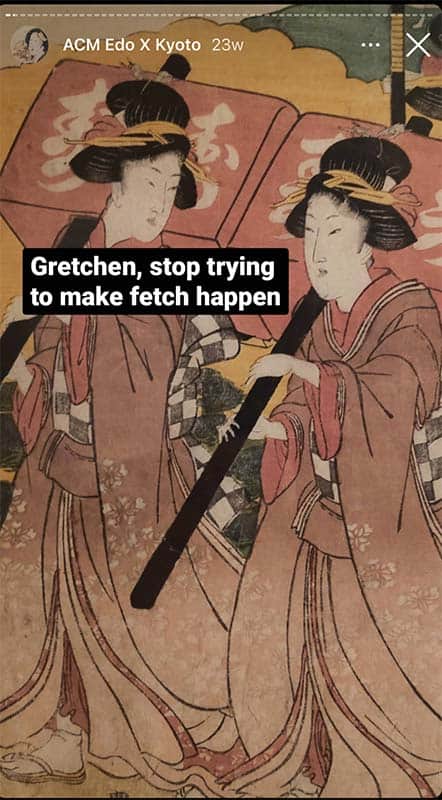
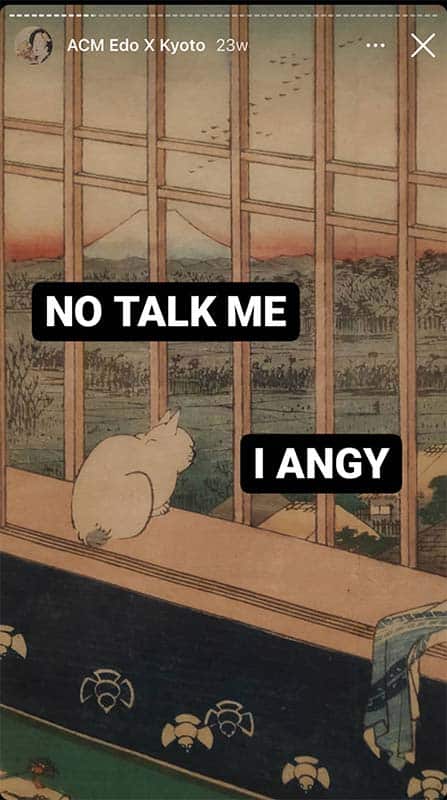
Just have fun with art! I want folks to know that there’s no pressure to look at artworks and artefacts the same way critics do. Sometimes, everyday life is a good enough lens to use to look at art. At the very least, we can just appreciate beauty and how it makes us feel.
There is no need to describe it: unless you’re on a museum date and you want to impress your plus one, then I wouldn’t recommend saying ‘wah’ to just about everything on display.
Here’s the thing: I know it’s easy for me to say all this because of my background in arts and heritage. I may look comfortable in a gallery, but the truth is that art still scares me. I’m constantly afraid that my takes miss whatever glaringly obvious point the artwork is trying to convey. This is a very normal fear to have. I work around these fears by knowing that if I found something funny, there’s a chance that someone else thinks the same.
I understand that you hope to remain anonymous but are you able to share a bit about your background and relationship with the art scene? If so, how did those experiences enrich your meme-making process?
While it hasn’t been for long, I’ve worked in and with museums before in various capacities. I also studied history at university locally, with an art history elective or two on the side. There are no prizes for guessing how these experiences help me run a page like @sgmuseummemes.
Besides my work and education, there’s also my background as a millennial. I grew up with early internet memes like rage comics and the classic Impact font image macros. I also observed how they have spread and transformed into the formats we have today. I’d like to think that this experience has given me a sensibility for memes.
Do you have any meme account inspirations?
Okay, this is gonna be long, so hang on tight!
I look to @artreviewpower100, @arthandlermag, @_the_art_of_installation_, and @internationalmountmakersforum for ideas when my experiences fall short. Shoutouts are in order too for @museumshift and @museumshit for being fellow museum roasters.
There are also the art world meme pages that have popped up closer to home. From Indonesia, we have @antikolektifkolektifclub, @indoartno, and @kuratormenganggur. And Thailand has a champion in @memeseumofcontemporaryartbkk. It’s really heartening to see that our neighbours have been memeing their art scenes too.
I also like my art memes to be a little more unique and specific so I look to @depressedartmemes, @chronicallycandidmemes, @punk_history and @art_historymemes.
Of course, I don’t just take inspiration from art and art world meme pages. I also follow a handful of regular meme pages to keep my meme game current. Pages like @on_a_downward_spiral, @69possums420 and @literallyeverymeme fall under this category. I also can’t talk about meme page inspirations without mentioning any from Singapore. You all know the big ones like @Yeolo.sg and @memedefsg. Other local favourites include @kmfst_ (Kiasu Memes for Singapore Teens) and @f*ckyeahnoms.
What has been your favourite exhibition from the past year that you have featured on your page? What about the worst exhibition, in your opinion?
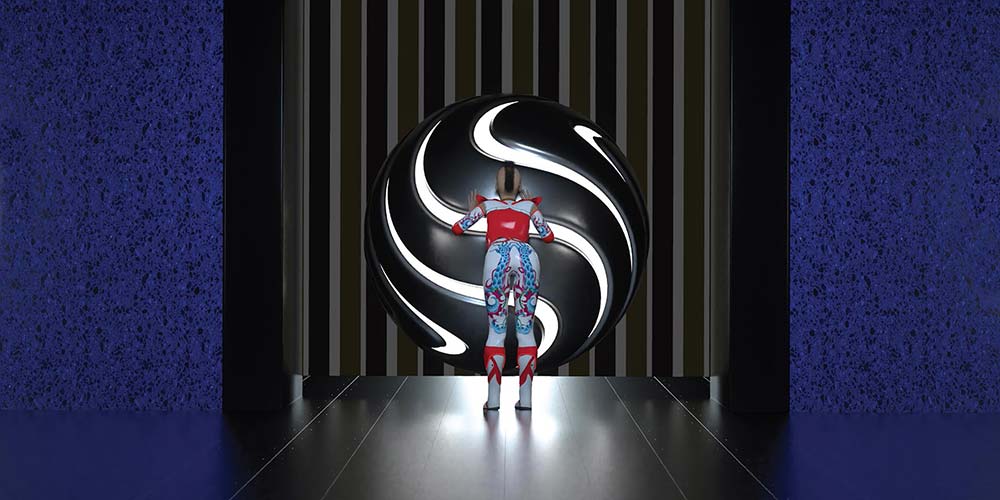
The best show of the year has to be the Singapore Art Museum’s (SAM) CosmicWander: Expedition, hands down. Choy Ka Fai’s exploration of shamanistic practices around the world (which somehow includes Yishun in Singapore) has been an uplifting and otherworldly tour de force. Of course, the fact that it was an epic multi-channel, surround sound set-up with smoke machines helped grease the experience along. I’m really glad that SAM is moving into Tanjong Pagar Distripark after that one test balloon (heh).
If I had to give an honourable mention, it would be the Asian Civilisation Museum’s Faith Beauty Love Hope. Strange title aside (shouldn’t there be an ‘and’ between ‘Love’ and ‘Hope’?), I liked the personal stories and insight from ACM’s staff and supporters, and the artefacts they picked. Besides these two exhibitions, I must also add that the military history side of me is excited that the Changi Chapel and Museum and Reflections at Bukit Chandu have both reopened recently.
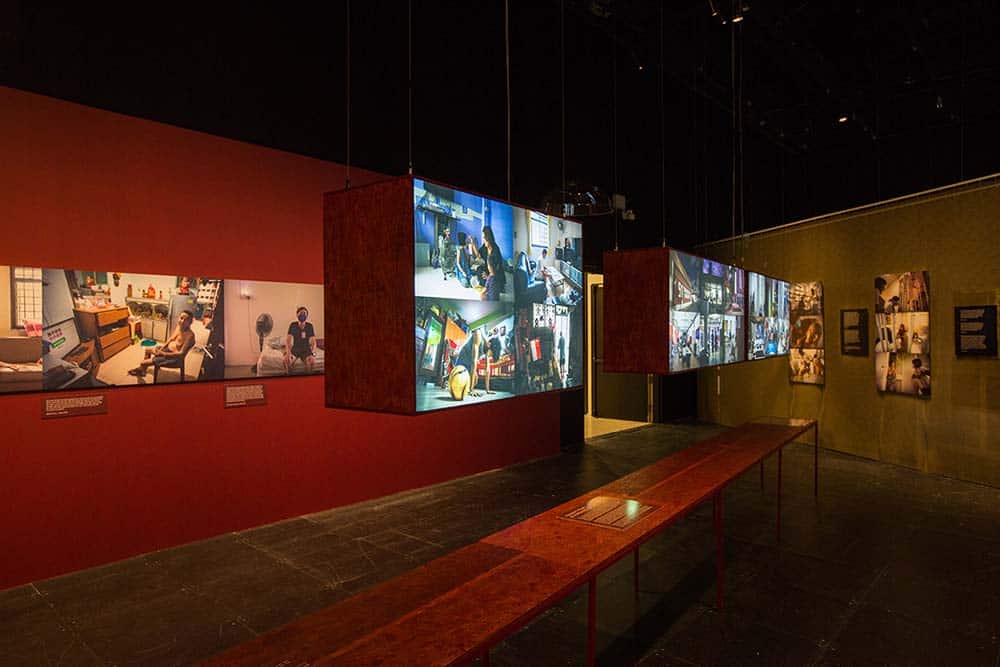
While I’m loath to call anything ‘the worst’, I’ve been very iffy about the National Museum of Singapore’s Picturing the Pandemic. To be fair, I appreciated how it offered various perspectives of the Circuit Breaker and the fact that it did not shy away from tough topics like the migrant worker dormitory outbreaks. Sure, there was the need to collect stories relating to the pandemic, but to present them now when we’re still in the thick of it strikes me as a little hasty. Besides that, I also feel that the items collected from the museum’s open call could have been better integrated into the show.
Do you have any personal insights from running the account that you’d like to share?
In my time working in the culture sector, I’ve found that I’ve almost always needed to tiptoe around things. Even while working incognito as @sgmuseummemes, I still find it difficult to speak about the art world directly without the fear of repercussions.
Besides that, I also need to always remind myself of two things. One: don’t get too hung up on the numbers. And two: I can always take a day or five off from posting. Running this page has anchored me through some pretty rough times in the past year. It has also been a source of stress too, so I need all the reminders to sit up, drink water, and touch grass I can get.
Finally, do you have any thoughts about the art media landscape at the moment? (Seeing that I am interviewing you, an anonymous art meme account, for a more traditional magazine format!)
There’s a chance that my opinion might not age well, but I don’t see a future without traditional art media. I think both platforms offer different forms of legitimacy. On one hand, traditional art media has the legitimacy of expert opinion. On the other, meme accounts have the legitimacy of mass relatability. I don’t think these concepts are mutually exclusive, and neither are they exclusive to traditional art media or the meme page. If I had to label the relationship between traditional art media and meme pages, this is how I would do it. After all, this interview wouldn’t be happening if I didn’t begin slapping funny labels onto artworks and artefacts, right?
_____________________________
Follow @sgmuseummemes’ work here: https://www.instagram.com/sgmuseummemes/
